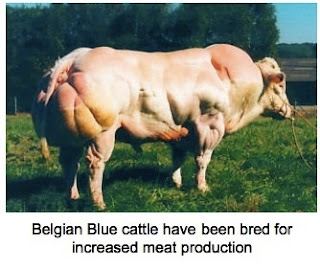
Humans use selective breeding (artificial selection) to improve features in ornamental plants, crop plants, domesticated animals and livestock.
- selective pressure: humans
- individuals with desirable features are chosen to interbreed = selective breeding
- some of these desirable alleles are passed onto offspring
- offspring with the most desirable features are chosen to interbreed
- this is repeated over many generations
Over many generations, alleles deemed desirable by the breeder increase in frequency, while the 'disadvantageous' ones may completely disappear over time.
Dairy cattle
 - desirable features: docility, fast growth rates, high milk yield
- desirable features: docility, fast growth rates, high milk yield- cows with desirable features are chosen to interbreed, and so are their offspring. This is repeated over many generations.
Bulls cannot be assessed for milk production as this is a sex-limited trait. Therefore, progeny testing is used: the performance of the bull's femail offpsirng is looked at to see whether or not to use the bull in further crosses
- background genes (alleles of genes that help an organism adapt to its particular environement) are also considered during artificial selection
Crop improvement
- Introduction of disease resistance to varieties of wheat and rice to reduce loss of yield resulting from such infections
- Incorporate mutant alleles for gibberellin synthesis into dwarf varieties --> increase proportion of energy put into each grain --> increase yield
- Inbreeding and hybridisation:
- When maize plants are inbred, the plants in each generation become progressively smaller and weaker. This inbreeding depression occurs because, in maize, homozygous plants are less vigorous than heterozygous plants.
- Challenge when growing maize: heterozygosity and uniformity
- Solution: Hybridisation - cross between 2 homozygous maize varieties --> find best hybrids
17.2 Natural and artificial selection
Populations of organisms have the potential to produce large numbers of offspring, yet their numbers remain fairly constant year after year. Humans use selective breeding (artificial selection) to improve features in ornamental plants, crop plants, domesticated animals and livestock. a) explain that natural selection occurs as populations have the capacity to produce many offspring that compete for resources; in the ‘struggle for existence’ only the individuals that are best adapted survive to breed and pass on their alleles to the next generation b) explain, with examples, how environmental factors can act as stabilising, disruptive and directional forces of natural selection c) explain how selection, the founder effect and genetic drift may affect allele frequencies in populations d) use the Hardy–Weinberg principle to calculate allele, genotype and phenotype frequencies in populations and explain situations when this principle does not apply e) describe how selective breeding (artificial selection) has been used to improve the milk yield of dairy cattle f) outline the following examples of crop improvement by selective breeding:
• the introduction of disease resistance to varieties of wheat and rice
• the incorporation of mutant alleles for gibberellin synthesis into dwarf varieties so increasing yield by having a greater proportion of energy put into grain
• inbreeding and hybridisation to produce vigorous, uniform varieties of maize
|

No comments:
Post a Comment